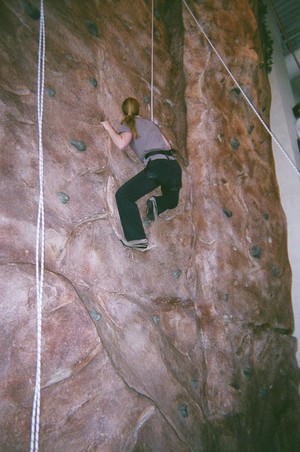All manner of sports enthusiasts suggest metaphorical comparisons between their chosen sports and life, each one offering a significant message to participants. The struggles, perseverance, overcoming of fear, nerves, the underdog’s victory and team unity are all sporty manifestations of important qualities for surviving and creating beautiful lives. Rock climbing is no different except for one clear and obvious exception. This is the fact the climber’s position, dangling from a rope which runs through the hands of a trusted belayer and a metal anchor at the top of the rock wall, further lends validity to this metaphor. For in climbing and in life, people creep their way on a journey from earth to heaven.
Once clipped in, connecting rope and harness, the climber communicates with the belayer in simple words meant to clarify safety and readiness. The first step onto the face of the rock may be easy. It is with patience and examination the climber must decide upon a route to attempt. Grasping the first handhold, stepping upon the first foothold, the climber then hoists upon the rock as the belayer tightens the slack in the rope.
A commitment is made with the first step onto the rock. There begins the acceptance of what is to come: the challenge of the ascent on a hard, often jagged surface, in the hopes of reaching the top only to end the climb by making the way back to safe ground, unscathed. The entire process requires trust in the rope, belayer, carabiners, anchors and personal strength to help the climber ascend and then rappel back to solid, horizontal ground.
Where the climber focuses can be seen as an indication of that person’s approach to life. Does the climber who looks down at the horizontal landing as he/she moves further up the rock focus on the past or the possibility of failure? Does a focus directly in front of the climber, looking at the rock face, reflect an inclination towards current choices without concern of the past or future? What about those climbers always looking ahead to their destination, noting each hold, knowing there is progress with each inch? Does the climber who lunges forth always hoping for quick advance somehow belittle slow, consistent progress Ultimately, these choices will affect the likelihood of either success or failure. But risks must be taken in order to achieve greatness. For some people, the risk is in making the first attempt at the climb.
Then, there is the struggle faced during the climb. As forearms begin to tire, toes become sore, hands begin to cramp and disco leg kicks into gear, the climber again makes choices which ultimately affect the end result. Each move requires the discovery of a fine balance between the security of each grip and all the other variables involved in the climb. While keeping the body just off the rock, maintaining the dynamics of gravity combined with pressure, weight and upward motion, the climber moves forwards. It is the combination of the climber’s trust and confidence in the people below and beneath the course, the equipment and faith in personal skill and strength which helps make the dyno/lunge to a hold just out of reach. All of these forces work together to hinder or facilitate the climber’s efforts.
Different climbers, gumbies or experienced, have their preferred methods for achieving the end result whether it is a cowbell in a climbing gym, a summit atop a mountain or the highest point of a boulder. Just as in life, there are choices to be made, attitudes which nuture success and failure. Each person has a perspective on overcoming the crux of the climb, their perception of the challenge and their personal strengths. No matter the destination, there is effort, often graceful, often risky and often challenging.
Upon completion of a route, a climber has several choices. One may choose another path. Another may decide to return to the same route until it is mastered. Finally, someone else may decide to stop climbing altogether. While one climber may begin with the easiest grade climb another, more confident or eager climber, may choose a more difficult grade. Do these decisions reflect repetition of old patterns, attempts at improvement or moving forward and learning lessons from past choices and outcomes? Does the decision to give up reflect a sense of lack of strength?
On the surface, climbing may appear to be an individual sport. However, there is a supportive team set in place, even for free climbers. It is how the climber views all that is around him/her in the environment that affects the individual’s perception of support. Woven nylon, metal carabiners, harnesses, crash pads, anchors and belayers are only a small part of the climber’s support system. The bag containing chalk used to temper moisture, securing the grip; shoes with a slight flexibility allowing the climber’s foot to mold more closely to the rock; cracks, jams, hands, feet, temperament, strength, flexibility, reach, dihedrals, edges, the occasional bucket, frequent crimps, cranks; the men and women both above and below who cheer the climber on while offering suggestions for moves and holds. All of these components affect the climber’s decision to either continue or bail and whether or not to strive towards completing the task at hand.
Most obvious of all the comparisons is the obvious metaphor of the multitude of choices for paths to the heavens while dangling in mid air, holding on for dear life. The goal is the heavens, but the climber is grounded to the earth by ropes and humans. Ropes anchored at the top of the climb (heavens) are also attached to the belayer who is grounded to the earth with the ascender dangling/struggling/finding a grip somewhere in between always hoping for progress, hoping to avoid a fall. But even the fall can be stopped and grip regained.
How one approaches each success or failure, lessons learned from experience and the care given to the support system all translate to the ways in which people choose to live through and master the struggles, trials and tribulations during their life on earth.
Veteran climbers with calloused fingers willingly share tales of views from dead hangs, terrifying screamers, honing focus, flappers and a whole array of events, emotions and injuries; how they overcame them and how they were gripped by them. Just as climbing offers those moments of challenge so, too, does life. It is how these challenges, both in life and in climbing, are faced that people learn the truth of their existence as humans. The gratitude and trust in support systems and one’s self can make the climb of life more manageable before finally ending upon a summit overlooking the natural landscape of one’s life and one’s destiny.


